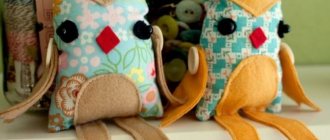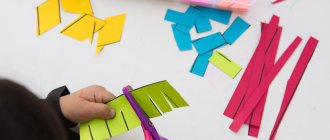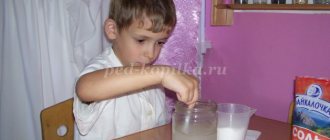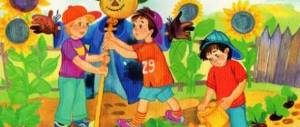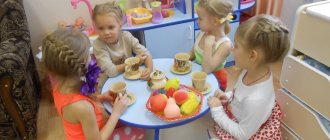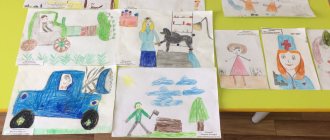Psychological characteristics of children of the younger group
Children 2-3 years old are very emotional and cannot yet control their emotions or switch from one emotion to another.
Their cognitive processes are involuntary in nature, that is, only the most interesting things that amazed the child are remembered. It is still difficult for a child to remember anything specifically. Acquaintance with the surrounding world is carried out through manipulations with objects; the visual-effective nature of thinking dominates. The game is also focused on objects; communication with other children does not generate interest. As a rule, speech at this age is also at the developing stage. It is with these developmental features of young children that the difficulties of using the dramatization method are associated. Dramatization games are more productive in the second youngest group with children 3-4 years old.
At the age of over 3 years, the child already begins to think not only with the help of objects, but also with images and ideas. However, cognitive activity is still focused on objects surrounding the child. Thinking, attention and memory are still involuntary. The type of communication changes somewhat; it becomes situational and businesslike. The child is drawn to the adult, he likes joint activities with elders. Speech continues to develop, so you should not expect detailed answers to questions or fluency in the role during performances from children 3-4 years old.
So, the capabilities of a younger preschooler are still quite small, but dramatization based on play will gradually develop the child’s cognitive and creative abilities.
Techniques for understanding the characters and plot of dramatizations by children of the 1st and 2nd junior groups
In order for kids to get used to the roles and empathize with their characters, they use many techniques. Thanks to them, the child develops comprehensively, they help his individuality to reveal itself. The following groups of techniques are distinguished:
- practical (creative);
- gaming;
- speech;
- visual.
Practical
By doing creative work, children delve deeper into the story and better understand its characters. Practical techniques include:
- crafts;
- applications;
- drawings.
When planning a lesson, it is important to take into account the capabilities and skills of the children. For younger groups, decorating coloring books based on the plots of fairy tales with paints and pencils is suitable. Children make appliqués from large pre-prepared parts. Crafts are created from one or more materials. For example, you can build the fairy tale “Kolobok” from colored paper and plasticine. The teacher guides the process.
Introducing a character in a drawing lesson
Additional Information! Typically, children engage in practical activities in related classes (club, drawing lesson). For example, they draw scenes from “Turnip” and other fairy tales. When planning a lesson, you should take into account the program of clubs and related lessons. So knowledge will be systemic.
Gaming
Their necessity is spelled out in the Federal State Educational Standard. Game activities are used for children of any age. But it is most relevant for the age category of 1.5 - 3 years. Children repeat movements and sounds after the teacher. In this way, simple elements of acting are learned. Over time, the games become more complex and include small fairy-tale dialogues.
Speech
The speech of the teacher of the younger group should be clear, figurative, and expressive. It is worth using proven speech techniques. These include:
- explanation;
- conversation;
- fairy tale;
- poems and riddles.
The explanation is suitable for learning new material and other stages of the lesson. The teacher gives the children the necessary information in short sentences. Speech should not contain turns, and new words should be immediately explained. It is worth supplementing verbal methods with visualization (depicting images with your hands, illustrations, presentation).
Project on artistic and aesthetic development according to the Federal State Educational Standard at a preschool educational institution
A conversation differs from an explanation because of the complexity of the teacher’s questions. While presenting the material, the teacher asks questions that require short answers. For example: “Who was the first to come to live in the tower?” During the conversation, questions are asked that need to be answered in detail. For example: “Why do we call the finger theater that way?”
Conversation before the performance
With the help of instructive tales, they instill in children the traits necessary for performances: discipline, attention to detail, accuracy. After listening to these stories, the kids become more organized, obedient, and independently remove the props after the theatrical performance.
Riddles and poems are read expressively, gesticulating. This develops artistry and memory, which are so necessary for dramatizations.
Important! In younger groups they use rhyme riddles in which the answers rhyme. This makes guessing easier. Children get used to rhyming language.
Visual
Visualize stories using:
- presentations;
- flannelograph;
- demonstrate using body language;
- pictures;
- decorations (for the fairy tale “Teremok” they make or draw a house).
Figures on flannelgraph, book illustrations, and photographs will help children consider the characters they need to play. The facial expressions of the characters and their intonations during dialogues are demonstrated by the teacher. Children observe and reproduce what they see.
Planning and stages of classes
Lessons in kindergarten are intense, dynamic, and consistent. Therefore, before a lesson, the teacher thinks through its structure, which should include:
- topic;
- goal (teach, develop, educate);
- materials used (toys, masks, costumes);
- organizational moment (game exercises are suitable - rhymes, nursery rhymes);
- introduction (where the teacher provides the information necessary to understand the topic);
- list of heroes;
- names of participants;
- the performance itself;
- reflection (final conversation in which participants reproduce what they heard and share emotions);
- rewarding participants for their efforts.
Based on these points, a lesson summary is created.
Goals and material support using the example of fairy tales
Topic: “Zayushkina’s hut”
Goals: to develop the ability to act out the plot of a familiar fairy tale; learn to reveal the characteristics of characters; cultivate the ability to empathize with your favorite characters; cultivate a desire to help and support.
Materials: hare house, foxes, costumes.
Theme: "Naughty Chick"
Objectives: teach to find the moral of a story; develop mindfulness; cultivate obedience.
Materials: eye-catching naughty chicken costume; the costumes of the rest of the chickens and the hen; illustrations (or a cartoon based on a fairy tale).
Topic: "Mitten"
Objectives: to improve the artistry of children; teach to imitate animals; develop memory; to cultivate benevolence and love of the child for nature.
Speech development in children of senior preschool age
Materials: large fabric or paper “mitten”, hero masks, cards for rewarding children.
Children put on "Mitten"
